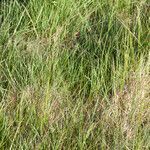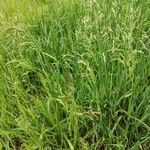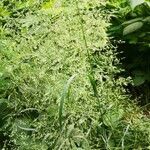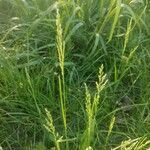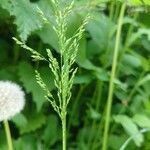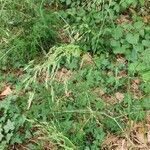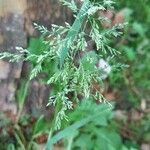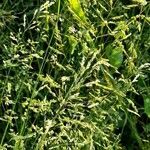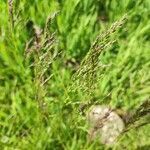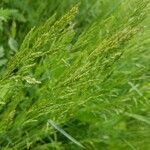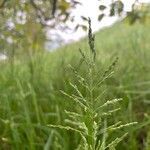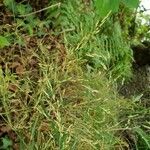Perennials, tufted, stoloniferous, shoots with or without beadlike swellings. Culms decumbent to geniculate, 20–100 cm tall, 1–2 mm in diam., nodes 3 or 4, scabrid below panicle and nodes. Lower leaf sheaths usually densely retrorsely scabrid, 8–15 cm, subequal to blade, uppermost closed for ca. 1/4 of length; blade flat, papery, 8–20 cm × 2–5 mm, surfaces scabrid, apex acuminate; ligule 3.5–10 mm, abaxially scabrid, acute to acuminate, collar smooth or scabrid, glabrous. Panicle oblong to pyramidal, 9–20 × 2–4 cm; branches obliquely ascending to spreading, 4–5 per node, densely scabrid throughout, longest ca. 4 cm with many spikelets crowded in distal 1/2, pedicels very short. Spikelets 2.5–3.5(–4) mm, florets 2 or 3; vivipary absent; glumes scabrid on keel, lower glume narrow, often sickle-shaped, 1.5–2 mm, 1-veined, upper glume 2.2–3 mm, 3-veined; lemmas ca. 2.5 mm, abaxial surface slightly arched, keel shortly villous for ca. 1/2 of length, marginal veins glabrous or pilulose to short-villous in lower 1/3, intermediate veins prominent, areas between veins minutely bumpy, glabrous; callus webbed, hairs long; palea subequal to lemma, minutely bumpy between keels, glabrous, keels minutely scabrid or bumpy. Anthers ca. 1.5 mm. Fl. and fr. May–Jul.
Stoloniferous perennial, usually caespitose. Culms 20–100 cm high; basal culm internodes often swollen; mid-culm internodes scabrous or glabrous, terete or compressed. Young shoots extravaginal. Leaves: basal sheaths with margins connate in lower 1/3 or shortly near base, usually retrorsely scabrous on nerves or sometimes smooth, often purplish; ligule 3–7 (–10) mm long, pointed, apically glabrous, abaxially glabrous or sparsely hairy; blade flat, (3–) 7.5–22 cm long, 1.5–5.2 (–6) mm wide, adaxially scabrous, abaxially glabrous or scabrous. Panicles open or contracted, 3–20 cm long. Spikelets 2.5–4 mm long, with 2 (–4) bisexual florets. Glumes narrowly acute; lower glume 1.9–2.6 mm long, 1-nerved; upper glume 2.3–2.9 (–3.5) mm long, 3-nerved. Web well-developed, with hairs often longer than lemma. Lemma 2.5–3.5 mm long, narrowly acute, distinctly incurved at apex, 5-nerved; keel and marginal nerves ciliate to villous in lower half; intermediate nerves usually glabrous; intercostal regions glabrous. Anthers 1.3–2.1 mm long.
Culms slender to stout, erect from a decumbent (even shortly stoloneous) base, 5–10 dm, without rhizomes, smooth or often scaberulous below the infl; sheaths finely scabrous; blades soft, 2–6 mm wide, the cauline ones often 15 cm; ligule (2.5–)3–7+ mm, panicle soon long-exsert, ovoid or oblong, the ascending branches in sets of 5–8, with numerous crowded spikelets; pedicels scabrous; spikelets ovate or elliptic, 2-fld and 2.7–3.2 mm or 3-fld and 3–4 mm; glumes lanceolate, incurved, the first 1.7–2.9 mm, the second 2–3.3 mm; lemmas thin, narrowly ovate, sharply 5-veined, acute or acuminate, glabrous except the scaberulous keel and webbed base; anthers 1–2 mm; 2n=14, 28. Native of Europe, intr. in meadows, moist woods, and along roadsides from Nf. to Minn. and S.D., s. to N.C. and Ill., and in the Pacific states.
Loosely to densely tufted perennial 200-900 mm high, spreading from a decumbent base; stolons creeping, leafy. Leaf blade 50-150 x 1-5 mm; ligule 3-10 mm long acute to acuminate. Inflorescence 75-200 mm long, ovate or pyramidal, open to contracted, branches in clusters of 3-7, undivided in lower parts, scabrid, less than own length apart; spikelets aggregated on upper part of branches. Spikelet (2)4-6 mm long, 2-5-flowered; lower glume 1-nerved; lemma keel short hairy from base to middle, margins glabrous rarely sparsely hairy near base, keel base densely woolly hairy; palea keels glabrous but scabrid; anthers 1.2-2.0 mm long.
Perennial, loosely tufted (spreading from a decumbent base) or rhizomatous (stolons creeping and leafy), 0.9 m high. Leaf blades 50-150 mm long, 1-5 mm wide; ligule ovate or oblong-acute, 4-6 mm long. Spikelets 4-5 mm long. Panicle ovate or pyramidal, 75-200 mm long, lowest branches whorled; spikelets 3-5-flowered, aggregated on upper part of branches; lemmas pilose on keel only; anthers ±1.5 mm long.
